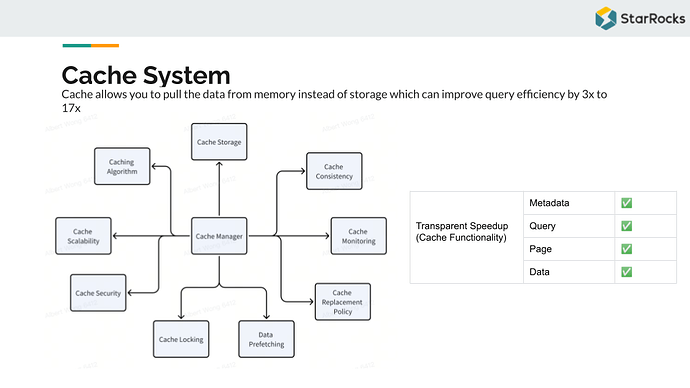Cache, in general, is a temporary storage area that holds frequently accessed data or computations, making them quickly available for future requests. It’s like a short-term memory for your system, reducing the need to repeatedly retrieve or calculate data from slower sources, leading to faster performance and reduced workload.
StarRocks offers two primary caching mechanisms to optimize query performance:
- Query Cache:
-
Purpose: Stores intermediate results of aggregate queries in memory.
-
Value:
-
Avoids redundant disk access and calculations for similar queries.
-
Significantly improves performance for frequent aggregate queries.
-
-
Usage:
-
Enabled by default, but configurable for size and eviction policies.
-
Most effective for queries with low-cardinality grouping columns.
-
- Data Cache:
-
Purpose: Caches data from external storage systems (e.g., S3) on StarRocks backends.
-
Value:
-
Reduces network I/O and speeds up queries accessing external data.
-
Particularly beneficial for hot data accessed repeatedly.
-
-
Usage:
-
Configured for specific external tables using a data cache policy.
-
Works with block-based caching for efficient retrieval.
-
Key Considerations for Effective Caching:
-
Cache Size: Allocate sufficient memory for caches to hold frequently accessed data.
-
Cache Invalidation: Ensure cached data remains consistent with underlying data.
-
Cache Hit Ratio: Monitor the effectiveness of caches in reducing data retrievals.
-
Cache Tuning: Adjust cache settings based on workload patterns and data access patterns.
Additional Caching Considerations in StarRocks:
-
Vectorized Cache: Optimizes vectorized query execution by caching intermediate results.
-
Result Cache: Stores final query results in memory for potential reuse.
-
By default, cache may be turned off. You can check your setting by reading https://docs.starrocks.io/docs/using_starrocks/query_cache/ and Data Cache | StarRocks.
In summary, caches are essential for maximizing query performance in StarRocks. By understanding the different types of caches and their strategic use cases, you can significantly improve query response times and overall system efficiency.

